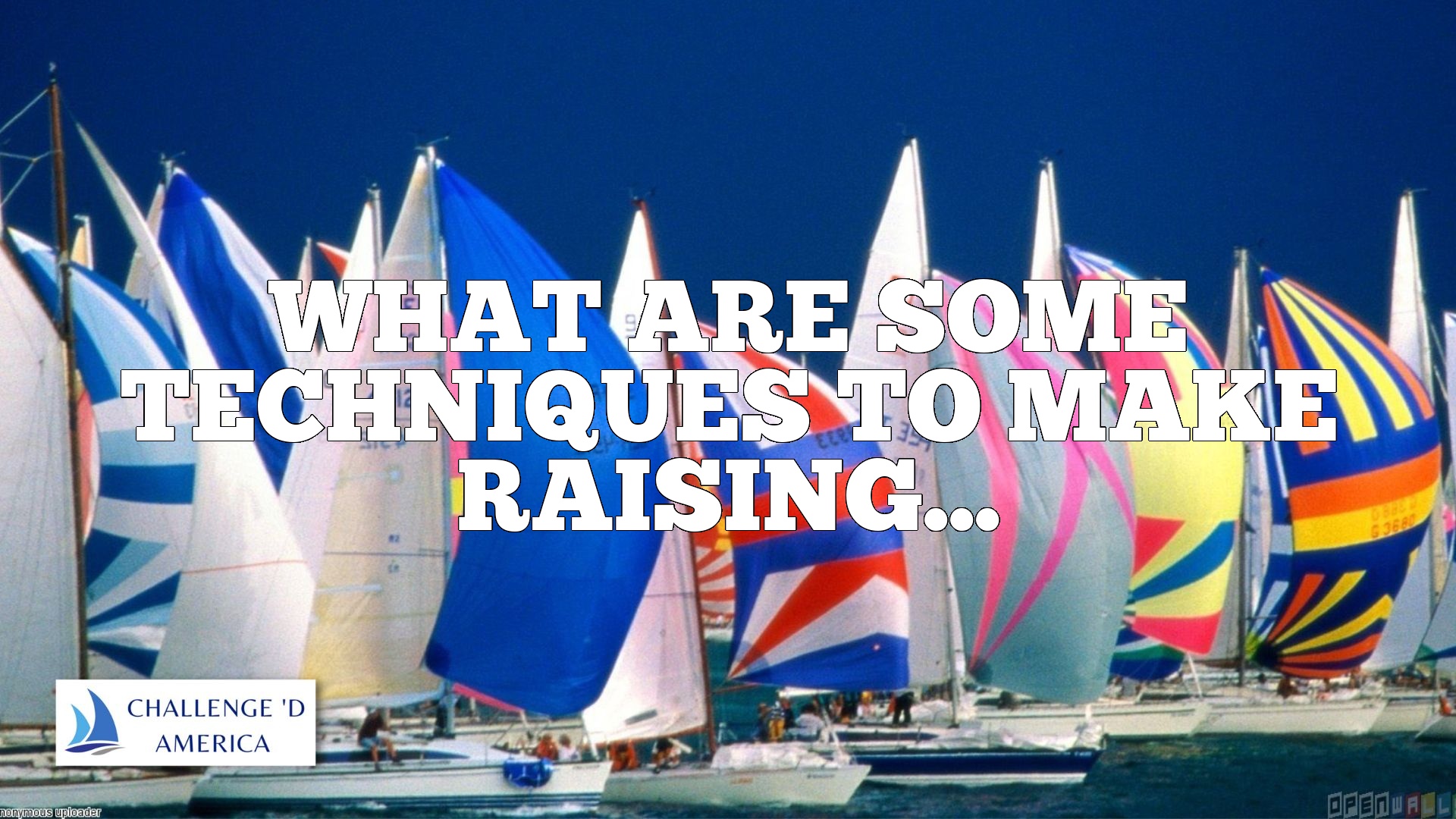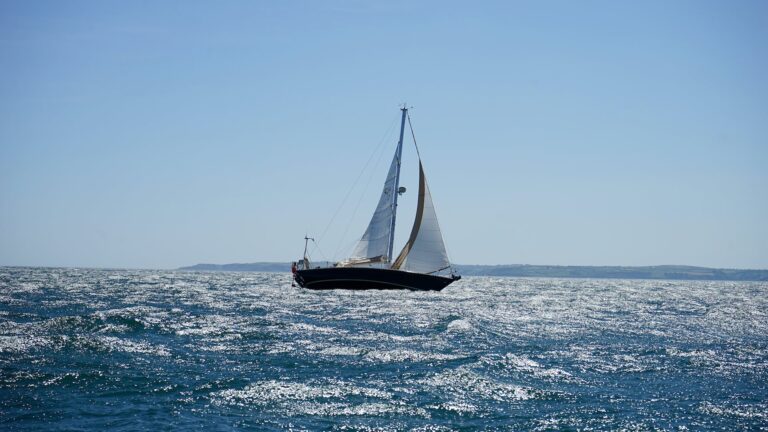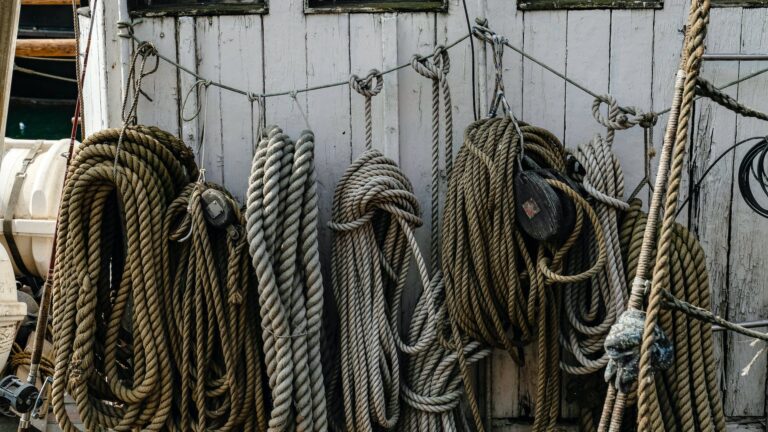What Are Some Techniques To Make Raising And Lowering The Mainsail Easier On A Sailboat?
Ahoy, fellow sailors! As a sailing expert and enthusiast, I know that raising and lowering the mainsail can be tricky work at times.
The mainsail is an incredibly important part of a sailboat and it is crucial to get it right. This article will take you through some expert techniques for making the process of raising and lowering the mainsail on a sailboat easier. Let’s hoist the mainsail and set sail!
Techniques To Make Raising And Lowering The Mainsail Easier
Raising and lowering the mainsail on a sailboat can be challenging, especially if the sail is large or the conditions are difficult.
There are a few techniques and tips to help make this process easier:
- Utilize a lazy jack system. This system consists of a number of lines that run across the mainsail, allowing the sail to be partially lowered without having to control the entire sail. The lines are rigged to the mast and the boom, allowing for a more organized control of the sail.
- Install a main sheet traveler. A traveler is a line that runs along the length of the boom, allowing for efficient and easy alteration of the mainsheet. This can be particularly helpful when lowering or raising the mainsail as it minimizes the amount of manpower required.
- Use a vang. A vang is a line that runs from the boom to the mast and helps to restrain the boom when hoisting or lowering the sail. This reduces the effort required to control the sail and makes the whole process easier.
- Consider using furling systems for the mainsail. Furling systems allow for the sail to be quickly and easily raised and lowered using the furling line. This method is efficient and requires minimal effort, making it a great option for those looking to make the process of raising and lowering the mainsail easier.
By utilizing these techniques, it is possible to make the process of raising and lowering the mainsail on a sailboat much easier. With the right setup, it can become a relatively simple process, allowing for more time spent sailing!
A. Use Of A Boom Vang
A boom vang is an essential component of any sailboat, and one of the key techniques to making mainsail raising and lowering easier.
The vang works to keep the boom in its proper position, preventing it from rising too far during sail hoisting, reducing strain on the halyard. The vang also helps to maintain the shape of the mainsail, which is essential for optimum sailing performance.
The boom vang is usually attached to the boom with a strong hook, and then leads up to the boom end with a line. The line can be adjusted to tension the vang and control how low the boom is. Some sailboats may also have adjustable vang blocks, which allow for better tension control.
To raise the sail, first release the vang, so that the boom is free to move upwards. Then, using the halyard, hoist the sail – the boom should stay in its proper position due to the vang. Finally, once the sail is raised, adjust the vang line to tension the vang and ensure the boom is in its optimal position.
Using a vang to control the boom during sail hoisting is an essential technique for any sailor, and makes the process of raising and lowering the mainsail much easier.
1. Definition Of Boom Vang
A boom vang or kicking strap is a piece of sailboat hardware used to control the boom and shape of the mainsail. It consists of a line attached at one end to the boom and at the other end at a cleat on the deck or to a block on the mast.
By adjusting the boom vang, the sailor can control the tension in the leech of the mainsail, which controls the draft of the sail, and thus its ability to generate power.
The boom vang also helps to keep the boom from rising too high in strong winds, which can result in an overpowered boat.
2. Benefits Of Using A Boom Vang
Using a boom vang is one of the most efficient and effective ways to make raising and lowering the mainsail easier on a sailboat.
A boom vang uses a line or cable, run between the boom and the deck, which provides support and leverage when hoisting the mainsail. It also helps to control the shape of the sail while underway, and provides extra stability in stronger winds.
The main benefits of using a boom vang are that it makes it much easier to raise and lower the mainsail without having to use a winch. It also allows for more precise sail shape control, as tension is applied to the luff of the sail.
This helps to reduce heel and provides greater stability, which makes sailing smoother and more comfortable. Additionally, by controlling the shape of the sail, a boom vang helps to increase the boat’s overall performance.
Overall, using a boom vang is an essential tool to make raising and lowering the mainsail much easier and more efficient. It also helps to ensure that the sail is properly trimmed for maximum performance, making sailing more enjoyable.
B. Use Of A Mainsail Furling System
A mainsail furling system is a great way to make raising and lowering the mainsail on a sailboat easier. This system allows you to lower and raise the mainsail from the cockpit without having to go up to the mast.
It does this by wrapping the sail around a foil mounted to the mast and running the furling line back to the cockpit.
Mainsail furling systems use either a luff groove, luff track, or external pocket system to allow the sail to be furled and unfurled. The luff groove system, also known as a foil luff grove, uses a groove in the foil to hold the luff of the sail to it.
A luff track system uses a track on the foil to guide the luff of the sail. The external pocket system uses a slide that slides into the pocket on the luff of the sail.
Mainsail furling systems can be either manual or electric. Manual systems require the user to manually pull the furling line to raise and lower the sail. Electric systems use a motor to raise and lower the sail and require a battery.
The use of a mainsail furling system can make raising and lowering the mainsail much easier on a sailboat. It removes the need to go to the mast and can be done from the comfort of the cockpit.
1. Definition Of Mainsail Furling System
A mainsail furling system is a type of sail control system that allows the mainsail of a sailing vessel to be partially or fully furled (rolled up) without having to leave the cockpit of the boat.
By making use of a mainsail furling system, sailors can more easily lower and raise the mainsail while they are underway, or even while they are in the harbor or mooring.
The process of furling and unfurling the mainsail can be done quickly and easily with this system, and it can be done with minimal physical effort.
The mainsail furling system consists of a sail luff tape, a furling line, a furling drum, and a sail feeder arm. The sail luff tape is attached to the foot of the mainsail and is the part that is wound around the furling drum.
The furling line is used to control the furling drum, allowing for precise control of the furling process. The sail feeder arm guides the mainsail onto the luff tape as it is being furled.
All of these components together allow for a smooth and efficient furling and unfurling process, and make it much easier to raise and lower the mainsail on a sailboat.
2. Benefits Of Using A Mainsail Furling System
A mainsail furling system is one of the best techniques to make raising and lowering the mainsail easier on a sailboat.
Mainsail furlers use a roller furling system, which helps sailors reduce the amount of effort required when reefing and unreefing the mainsail.
Reefing is the process of shortening the sail by rolling part of the mainsail around the mast. Unreefing is the opposite, and is the process of unrolling the mainsail from the mast.
A mainsail furling system offers several benefits to sailboat owners. Firstly, it reduces the amount of time and effort needed to reef and unreef the mainsail.
It also keeps the mainsail furled and secured to the mast, so it is not vulnerable to wind or gusts on the water.
In addition, mainsail furlers allow you to reef and unreef your mainsail easily while you are sailing, which can be beneficial when the wind picks up suddenly.
Lastly, they help you keep your sails in good condition as they reduce the wear and tear from raising and lowering the sail every time you go sailing.
Overall, using a mainsail furling system is a great way to make raising and lowering the mainsail easier and more efficient on a sailboat. It offers a variety of benefits for sailboat owners including time and effort savings, improved sail security, and better sail condition.
C. Use Of A Mainsheet System
The use of a mainsheet system is another useful technique to make raising and lowering the mainsail easier on a sailboat.
A mainsheet system is a type of rigging that is used to control the shape and position of the sail by attaching it to a mainsheet block. This allows for more precise and efficient control of the sail and makes raising and lowering the mainsail much easier.
Mainsheet systems are typically composed of a mainsheet block, a clew line, a clew outhaul, and a vang. The mainsheet block is the main connection point for the sail and typically attaches to the boom vang, which is a type of rigging that is used to keep the boom horizontally in place.
The clew line is then attached to the mainsheet block and is used to control the position of the clew of the mainsail.
The clew outhaul is then threaded through the clew line and is used to adjust the tension of the sail. Finally, the vang connects the boom to the mast, and is used to control the angle of the boom.
By using a mainsheet system, the sailor can easily control the shape and position of the mainsail, making it much easier to raise and lower. Additionally, the mainsheet system can be adjusted according to the wind conditions, allowing for great versatility in sail trim.
1. Definition Of Mainsheet System
The mainsheet system on a sailboat is a collection of lines and hardware that are used to control the mainsail.
It is composed of the mainsheet, which is the primary line used to adjust the angle of the mainsail to the wind, as well as the blocks, cleats, travellers and other hardware that the mainsheet runs through.
The mainsheet is typically the largest single line on a sailboat and is either tied to the boom directly or is led through a traveller car and then tied to the boom.
By adjusting the mainsheet, the sail shape of the mainsail can be changed and the angle of the sail to the wind can be adjusted, thereby allowing the helmsman to control the speed and direction of the sailboat.
2. Benefits Of Using A Mainsheet System
One of the main techniques for making raising and lowering the mainsail easier on a sailboat is by making use of a mainsheet system.
A mainsheet system can provide a number of advantages to a sailor, including improved stability, control and performance of the boat.
Stability – A mainsheet system has the ability to provide a stable platform to the boat by enabling control of the mainsail’s shape and position. This allows the boat to maintain its optimal trim and sail shape, which in turn improves its overall stability.
Control – A mainsheet system allows the sailor to control the positioning of the mainsail relative to the boat, allowing them to adjust the sail’s shape and angle relative to the wind. This allows the sailor to set up their boat for the most optimum performance and to easily adjust the trim of their sail as the conditions change.
Performance – A mainsheet system allows the sailor to improve their sailing performance, as it enables them to easily adjust the trim of the mainsail and make use of optimal sail settings for the specific conditions. This results in the boat being able to sail faster and more efficiently, and improve overall racing performance.
Overall, using a mainsheet system provides a number of benefits to a sailor, including improved stability, control, and performance of the boat. This makes raising and lowering the mainsail easier and more efficient, and helps to maximise the performance of the boat.
D. Use of A Downhaul System
The use of a downhaul system is another way to make raising and lowering the mainsail easier on a sailboat. A downhaul system is a special setup used to tension the mainsail luff and help deploy the sail quickly and in a controlled manner.
It consists of a line, typically made of either nylon or wire, which is used to pull down on the sail’s halyard or clew. This action tensions the sail’s luff and helps open the sail to the wind, allowing it to fill with air and achieve lift.
A downhaul system is typically used in conjunction with a set of lazy jacks, which are guide lines attached to the mainsail’s head and clew.
This allows the mainsail to be moved in a controlled manner, so that it is not dragged across the deck as it is lowered. This is especially beneficial in light winds, when the sail is less likely to be filled with air and can be difficult to handle.
For those looking to make their raising and lowering of the mainsail easier, a downhaul system is an effective and relatively simple solution. It can be easily set up and offers the advantages of better sail control and less fatigue for the crew.
1. Definition Of Downhaul System
A downhaul system is an important component of a sailboat’s rigging and is used to control the tension of the mainsail.
It is a rope and pulley system that runs from the head of the mainsail, down to the boom and to the cockpit thus allowing the crew to make adjustments to the tension on the sail from the cockpit.
This is done by tightening or loosening the downhaul line, which in turn adjusts the tension in the luff of the sail. The tighter the downhaul, the more the sail is flattened against the mast, making it less powerful and easier to handle.
The downhaul system is an invaluable tool for quickly and easily adjusting the tension on the mainsail, thus making sail handling easier.
2. Benefits Of Using A Downhaul System
A downhaul system is an essential piece of equipment on a sailboat as it can make raising and lowering the mainsail easier.
This system includes a rope connected to the clew of the sail and running through a block at the masthead. The rope is then led back down towards the cockpit, allowing the helmsman to pull the clew down against the mast, making it easier to raise the mainsail.
Using a downhaul system can bring a number of benefits to the process of raising and lowering the mainsail.
Firstly, it can reduce the amount of effort needed to raise and lower the sail as the line allows the helmsman to pull the clew down against the mast.
Secondly, the tension applied to the clew can reduce the amount of shape lost in the sail when it is lowered which can help with getting the sail back up quickly and efficiently.
Thirdly, the downhaul can help to keep the sail from flogging which is a particular issue when the wind gusts.
Finally, the downhaul line can be used to tension the leech of the sail which can help to reduce the amount of windage, resulting in improved performance.
These are just some of the benefits of using a downhaul system when raising and lowering mainsails on a sailboat.
It is an easy to use and effective system which can help to make the process of raising and lowering the mainsail safe and efficient.
Summary: What Are Some Techniques To Make Raising And Lowering The Mainsail Easier On A Sailboat?
Raising and lowering the mainsail on a sailboat can be a daunting task, especially if you are new to sailing. However, there are a few techniques that can make the process much easier.
First, ensure that you have the proper line setup and that all lines involved in the process are in good condition. To hoist the mainsail, use the mainsheet to control the angle of the boom and the halyard to raise the sail.
You can also utilize a topping lift or lazy jacks to provide additional support to the boom and mainsail. As for lowering the mainsail, use the halyard to bring the sail down, making sure to keep tension on the mainsheet.
Finally, secure the mainsail by cleating the halyard and mainsheet. With the proper knowledge and practice, these skills will eventually become second nature to any sailor.
FAQs
Are You Using A Single-Line Or Double-Line System?
As a sailing expert, I can confidently say that the best choice when it comes to raising and lowering the mainsail on a sailboat is to use a double-line system. A double-line system allows for easier control of the sail, as it utilizes two halyards (the lines attached to the sail) instead of just one.
The two halyards are then attached to two winches (a mechanical device used to pull in a line) located on the mast, so that each line can be raised or lowered independently.
This allows you to easily adjust the sail’s trim while sailing, and makes it easier to raise and lower the mainsail since you can use both hands to raise and lower the sail.
What Type Of Winch Do You Have?
When it comes to making raising and lowering the mainsail easier on a sailboat, the type of winch you have is a critical factor. Most sailboats today are equipped with either a self-tailing winch or a two-speed winch.
A self-tailing winch is designed to hold the sheets or halyards in place automatically. This eliminates the need to manually wrap the lines around the winch, making it much easier to control the sail.
A two-speed winch offers two different gear ratios, allowing you to use a higher gear for faster sail raising and a lower gear for a smoother, quieter operation.
Both of these winches can be powered manually or electrically, giving you a wide range of options depending on your needs.







![sailing-bedroom-sailboat-cabin What Do You Call a Bedroom On a Sailboat?[Editing Required]](https://challengedamerica.org/wp-content/uploads/2023/02/sailing-bedroom-sailboat-cabin-768x432.jpg)